法隆寺の宮大工で、最後の棟梁と呼ばれた西岡常一さんの著書。法隆寺の宮大工でありながら、薬師寺の再建を担当された時の話を書かれています。通訳ガイドで奈良を案内する場合、東大寺の大仏殿が多く、時々法隆寺に行く方がいらっしゃる程度と思います。なかなか薬師寺まで足を延ばしてのご案内は少ないかもしれません。
薬師寺は長い歴史の中で、火災や自然災害のためにほとんどの建物が壊れ、東塔だけが残っていたそうで、それを金堂、西塔、中門と復元して、その後に三蔵院、大講堂、回廊も再建し、現在に至っています。
西岡さんによると、薬師寺は法隆寺に比べ50年程度経ってから建てられており、中国大陸の長安から直接入った新しい様式で建てられています。法隆寺は力強く、薬師寺は強いものを優しく見せようという違いがあります。
ガイドの方は、屋根の上にのっているシビを海外の方に説明する機会が多々あると思いますが、どのように説明されているでしょうか。水の中に居る生き物で、「魚の尾びれ」との説明でしょうか。確かに、火災予防のために建物全体が水の中にあるイメージも、通俗的な説明として、良いとは思います。
西岡さんによると、この“シビ”は鳥の尾の形を表しているそうです。そして、屋根の反りは鳥の翼を表し、2尾の鳥が抱き合っている形との説明です。詳しいことは本書に譲りますが、これはこれで、海外の方も興味を持ってくれるのではないでしょうか。
西岡棟梁が再建に尽力された西塔の土台は、少し東塔よりも地面から高くなっているそうです。数百年後に、自重で沈んで東塔と同じ見栄えになるとのことで、屋根の反りの上がり具合も、そのように計算しているとのことです。薬師寺に訪問の際は、東塔と西塔の微妙な差異に込められた、西岡さんの思いを見つけてみてください。(完)

木に学べ 法隆寺・薬師寺の美(小学館文庫) [ 西岡 常一 ]
価格:607円
(2021/6/30 09:24時点)
感想(15件)
Learn from the trees.(English)
This is a book written by Tsunekazu Nishioka, the palace carpenter of Horyuji Temple, who was known as He wrote about his experience when he was in charge of the reconstruction of Yakushiji Temple while he was the palace carpenter of Horyuji Temple. If you are an interpreter guide, you will probably visit the Great Buddha Hall at Todaiji Temple most of the time, and sometimes you will visit Horyuji Temple. It may be rare for interpreters to visit Yakushiji Temple.
In the long history of Yakushiji Temple, most of the buildings were destroyed due to fires and natural disasters, and only the east pagoda was left. The Kondoa (main hall), the west pagoda, and the central gate were restored, and later the Sanzoin, the main lecture hall, and the cloister were also rebuilt.
According to Mr. Nishioka, Yakushiji Temple was built about 50 years later than Horyuji Temple, and it was built in a new style that came directly from Chang’an in mainland China. There is a difference between Horyuji Temple, which is powerful, and Yakushiji Temple, which tries to make something strong look gentle.
I’m sure that many guides have the opportunity to explain the “Shibi” on the roof to people from overseas, but how do you explain it? It is a creature that lives in the water, and is probably described as “the tail fin of a fish. It is true that the image of an entire building under water for fire prevention is also a good one, as a common explanation.
According to Mr. Nishioka, this “Shibi” represents the shape of a bird’s tail. The warp of the roof represents the wings of a bird, and the shape of two birds hugging each other. I’ll leave the details to this book, but I’m sure this will be of interest to people from overseas.
The foundation of the West Pagoda, which Mr. Nishioka worked hard to rebuild, is slightly higher from the ground than that of the East Pagoda. It is said that after a few hundred years, it will sink under its own weight and look the same as the East Pagoda, and the degree of warping of the roof was calculated accordingly. When you visit Yakushiji Temple, please try to find Mr. Nishioka’s thoughts in the subtle differences between the east and west pagodas.
Apprenez des arbres. (Français)
Il s’agit d’un livre écrit par Tsunekazu Nishioka, le charpentier du palais du temple Horyuji, qui était connu sous le nom de Il a écrit sur son expérience lorsqu’il était chargé de la reconstruction du temple Yakushiji alors qu’il était le charpentier du palais du temple Horyuji. Si vous êtes guide interprète, vous visiterez probablement la salle du Grand Bouddha du temple Todaiji la plupart du temps, et parfois vous visiterez le temple Horyuji. Il peut être rare que les interprètes visitent le temple Yakushiji.
Au cours de la longue histoire du temple Yakushiji, la plupart des bâtiments ont été détruits par des incendies et des catastrophes naturelles, et seule la pagode est est restée. Le Kondoa (hall principal), la pagode ouest et la porte centrale ont été restaurés, et plus tard, le Sanzoin, la salle de conférence principale et le cloître ont également été reconstruits.
Selon M. Nishioka, le temple Yakushiji a été construit environ 50 ans plus tard que le temple Horyuji, et il a été construit dans un nouveau style qui vient directement de Chang’an en Chine continentale. Il y a une différence entre le temple Horyuji, qui est puissant, et le temple Yakushiji, qui essaie de donner à quelque chose de fort une apparence douce.
Je suis sûr que de nombreux guides ont l’occasion d’expliquer le “Shibi” sur le toit à des personnes venant de l’étranger, mais comment l’expliquer ? Il s’agit d’une créature qui vit dans l’eau, et qui est probablement décrite comme “la nageoire caudale d’un poisson”. Il est vrai que l’image d’un bâtiment entier sous l’eau pour la prévention des incendies est également une bonne explication courante.
Selon M. Nishioka, ce “Shibi” représente la forme de la queue d’un oiseau. La chaîne du toit représente les ailes d’un oiseau, et la forme de deux oiseaux qui s’enlacent. Je vais laisser les détails à ce livre, mais je suis sûr que cela intéressera les gens d’outre-mer.
Les fondations de la pagode ouest, que M. Nishioka a travaillé dur à reconstruire, sont légèrement plus hautes que celles de la pagode est. Il est dit qu’après quelques centaines d’années, elle s’affaissera sous son propre poids et aura le même aspect que la pagode Est, et le degré de déformation du toit a été calculé en conséquence. Lorsque vous visiterez le temple Yakushiji, essayez de retrouver les pensées de M. Nishioka dans les différences subtiles entre les pagodes est et ouest.
